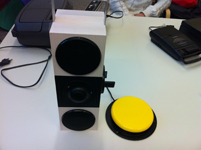|
In the first part, the pupils discuss the situation of three people with reduced motor function. During the second part, the pupils make a simple disability aid. The third part consists of a discussion task using an authentic situation.
Exercise 1
Use the worksheet with the three pictures and explanatory text.
What these three people have in common is that they all have a disability:
- The woman in the first picture has an artificial arm controlled by her brain.
- The man in the second picture finds it difficult to walk without his walking frame
- The woman in the third picture has a motorized wheelchair
In this case, the pupils are to discuss the problems faced by these three people. Try to imagine what situations they might find difficult to cope with. Some of their problems are eased by the technical aids they have been equipped with. Discuss and give examples of how technology can be of help to people with reduced motor function, in various situations.
Exercise 2
Discuss how, with the help of technology, we can help a person who cannot talk and cannot move below the head. One idea would be to fasten a torch on a headband and use the lamp to point at different things.
Exercise 3
In this case we use the case of a patient who has reduced fine motor skills and therefore has difficulty in pushing small switches on electrical appliances. The picture on the left shows a large switch available for purchase. The task for the pupils is to build a switch like the one in the picture on the right, which is made of two CD discs. The scientific principle used here is the electrical circuit.
Exercise 4
Start from the situation of a handicapped person who needs an adapted car. Let the pupils discuss what adaptations they think might be possible.
Some suggestions:
- A joystick to steer instead of the usual steering wheel
- A specially-adapted air filter for asthmatics
- An individually-fitted driver’s seat
- Foot-steering for people with reduced arm function
- Accelerator and brake pedals adapted for use by the left foot if for some reason one cannot use the right one
- Interior heaters so one doesn’t need to scrape ice from the windows in winter
- Luggage crane or robot arm for ease of loading/unloading an electric wheelchair.
 |
 |
 |
 |
 |
| Robotic arm for loading the wheelchair |
Robotic ramp for wheelchair |
Controls mounted directly on the wheel |
Knob operated by foot |
Car with only one foot pedal for patients with paralyzed left leg |
Technological developments take place all the time and it is easy to find newspaper articles, television reports and films on www.youtube.com (search tips: artificial hand, artificial arm, etc.)
|









